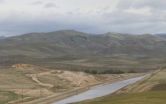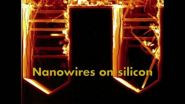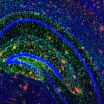(Press-News.org) Winter rains and summer groundwater pumping in California's Central Valley make the Sierra Nevada and Coast Mountain Ranges sink and rise by a few millimeters each year, creating stress on the state's faults that could increase the risk of an earthquake.
Gradual depletion of the Central Valley aquifer, because of groundwater pumping, also raises these mountain ranges by a similar amount each year--about the thickness of a dime--with a cumulative rise over the past 150 years of up to 15 centimeters (6 inches), according to calculations by a team of geophysicists.
The scientists report their results in this week's issue of the journal Nature.
While the seasonal changes in the Central Valley aquifer have not yet been firmly associated with any earthquakes, studies have shown that similar levels of periodic stress, such as that caused by the motions of the moon and sun, increase the number of microquakes on the San Andreas Fault.
If these subtle seasonal load changes are capable of influencing the occurrence of microquakes, it's possible that they can sometimes also trigger a larger event, said Roland Bürgmann, a geoscientist at the University of California, Berkeley and co-author of the Nature paper.
"The stress is very small, much less than you need to build up stress on a fault leading to an earthquake, but in some circumstances such small stress changes can be the straw that breaks the camel's back," Bürgmann said. "It could just give that extra push to get a fault to fail."
The study, based on GPS measurements from California and Nevada between 2007 and 2010, was led by scientists Colin Amos at Western Washington University and Pascal Audet of the University of Ottawa.
The detailed GPS analyses were performed by William Hammond and Geoffrey Blewitt of the University of Nevada, Reno, as part of a National Science Foundation (NSF) grant. Hammond and Blewitt, along with Amos and Audet, are also co-authors of this week's paper.
"Other studies have shown that the San Andreas Fault is sensitive to small-scale changes in stress," said Amos.
"These appear to control the timing of small earthquakes on portions of the fault, leading to more small earthquakes during drier periods of the year. Previously, such changes were thought to be driven by rainfall and other hydrologic causes."
This work ties overuse of groundwater by humans in the San Joaquin Valley to increases in the height of nearby mountain ranges and possible increases in the number of earthquakes on the San Andreas Fault, said Maggie Benoit, program director in NSF's Division of Earth Sciences, which funded the research.
"When humans deplete groundwater," said Benoit, "the amount of mass or material in Earth's crust is reduced. That disrupts Earth's force balances, causing uplift of nearby mountains and reducing a force that helps keep the San Andreas fault from slipping."
Draining of the Central Valley
Water has been pumped from California's Central Valley for more than 150 years, changing what used to be a marsh and extensive lake, Tulare Lake, into fertile agricultural fields.
In that time, about 160 cubic kilometers (40 cubic miles) of water was removed--the capacity of Lake Tahoe--dropping the water table in some areas more than 120 meters (400 feet) and the ground surface 5 meters (16 feet) or more.
The weight of water removed allowed the underlying crust or lithosphere to rise by so-called isostatic rebound, which may have raised the Sierra as much as half a foot since about 1860.
The same rebound happens as a result of the state's seasonal rains.
Torrential winter storms drop water and snow across the state, which eventually flow into Central Valley streams, reservoirs and underground aquifers, pushing down the crust and lowering the Sierra 1-3 millimeters.
In the summer, water flow into the Pacific Ocean, evaporation and ground water pumping for irrigation, which has accelerated because of drought, allows the crust and surrounding mountains to rise again.
Bürgmann said that the flexing of Earth's crust downward in winter would clamp the San Andreas fault tighter, lowering the risk of quakes, while in summer the upward flexure would relieve this clamping and perhaps increase the risk.
"The hazard is ever so slightly higher in the summer than in the wintertime," he said. "This suggests that climate and tectonics interact, and that water changes ultimately affect the deeper Earth."
High-resolution mapping with continuous GPS
Millimeter-precision measurements of elevation have been possible only in the last few years. Improved continuous GPS networks--part of the NSF EarthScope Plate Boundary Observatory, which operates 1,100 stations around the western United States--and satellite-based interferometric synthetic aperture radar have provided the data.
The measurements revealed a steady yearly rise of the Sierra of 1-2 millimeters per year, which was initially ascribed to tectonic activity deep underground, even though the rate was unusually high.
The new study provides an alternative and more reasonable explanation for the rise of the Sierra in historic times.
"The Coast Range is doing the same thing as the Sierra Nevada, which is part of the evidence that this can't be explained by tectonics," Bürgmann said.
"Both ranges have uplifted over the last few years and both exhibit the same seasonal up and down movement in phase. This tells us that something has to be driving the system at a seasonal and long-term sense, and that has to be groundwater recharging and depletion."
In response to the current drought, about 30 cubic kilometers (7.5 cubic miles) of water has been removed from Central Valley aquifers between 2003 and 2010, causing a rise of about 10 millimeters (2/5 inch) in the Sierra over that time.
INFORMATION:
California Central Valley groundwater depletion slowly raises Sierra Nevada mountains
Changes may trigger small earthquakes, scientists find
2014-05-14
ELSE PRESS RELEASES FROM THIS DATE:
Nanowire bridging transistors open way to next-generation electronics
2014-05-14
VIDEO:
UC Davis engineer Saif Islam explains how growing semiconductor nano-sized wires and bridges on silicon can lead to a new generation of robust electronic devices.
Click here for more information.
A new approach to integrated circuits, combining atoms of semiconductor materials into nanowires and structures on top of silicon surfaces, shows promise for a new generation of fast, robust electronic and photonic devices. Engineers at the University of California, Davis, have ...
Societies publish recommendations to guide minimally invasive valve therapy programs for patients
2014-05-14
WASHINGTON, D.C., BEVERLY, MA, and CHICAGO (May 15, 2014) – As minimally invasive therapies are increasingly used to treat diseased heart valves, newly published recommendations provide guidance on best practices for providing optimal care for patients. The document released today offers first-time guidance from four professional medical associations on developing and maintaining a transcatheter mitral valve therapy program, emphasizing collaboration between interventional cardiologists and cardiac surgeons. The document is an important step toward achieving consistent, ...
Inhibiting protein family helps mice survive radiation exposure, Stanford study finds
2014-05-14
STANFORD, Calif. - Tinkering with a molecular pathway that governs how intestinal cells respond to stress can help mice survive a normally fatal dose of abdominal radiation, according to a new study by researchers at the Stanford University School of Medicine.
Because the technique is still partially effective up to 24 hours after exposure, the study suggests a possible treatment for people unintentionally exposed to large amounts of radiation, such as first responders at the Chernobyl nuclear disaster in 1986.
"We were very surprised by the amount of protection the ...
Antidepressant may slow Alzheimer's disease
2014-05-14
A commonly prescribed antidepressant can reduce production of the main ingredient in Alzheimer's brain plaques, according to new research at Washington University School of Medicine in St. Louis and the University of Pennsylvania.
The findings, in mice and people, are published May 14 in Science Translational Medicine. They support preliminary mouse studies that evaluated a variety of antidepressants.
Brain plaques are tied closely to memory problems and other cognitive impairments caused by Alzheimer's disease. Stopping plaque buildup may halt the disastrous mental ...
Can anti-depressants help prevent Alzheimer's disease?
2014-05-14
PHILADELPHIA – A University of Pennsylvania researcher has discovered that the common selective serotonin reuptake inhibitor (SSRI) citalopram arrested the growth of amyloid beta, a peptide in the brain that clusters in plaques that are thought to trigger the development of Alzheimer's disease (AD). Penn, in collaboration with investigators at Washington University, tested the drug's effects on the brain interstitial fluid (ISF) in plaque-bearing mice and the cerebrospinal fluid (CSF) of healthy human subjects to draw its conclusions, which are detailed in the new issue ...
Hitting a moving target
2014-05-14
LA JOLLA, CA—May 14, 2014—A vaccine or other therapy directed at a single site on a surface protein of HIV could in principle neutralize nearly all strains of the virus—thanks to the diversity of targets the site presents to the human immune system.
The finding, from a study led by scientists at The Scripps Research Institute (TSRI), is likely to influence future designs for HIV vaccines and antibody-based therapies.
"We found, for example, that if the virus tries to escape from an antibody directed at that site by eliminating one of its sugars, the antibody often ...
Deformable mirror corrects errors
2014-05-14
This news release is available in German.
Lasers are used in manufacturing to cut materials or weld components together. Laser light is focused to a point using various lenses and mirrors; the smaller the focal point and the higher the energy, the more accurately operators can work with the laser. So, turn up the power and off you go, right? It is not that simple because when laser power increases, the mirror heats up accordingly, causing it to deform. A deformed mirror cannot effectively focus the laser; the focal point gets bigger and laser power falls away.
Precisely ...
Victims want to change, not just punish, offenders
2014-05-14
Revenge is a dish best served with a side of change.
A series of experiments conducted by researchers affiliated with Princeton University has found that punishment is only satisfying to victims if the offenders change their attitude as a result of the punishment.
"Revenge is only 'sweet' if the person reacts with a change in attitude, if the person understands that what they did was wrong. It is not the act itself that makes punishment satisfying," said Friederike Funk, a Princeton graduate student in psychology and one of the researchers.
The findings offer insights ...
Study shows breastfeeding, birth control may reduce ovarian cancer risk in women with BRCA mutations
2014-05-14
PHILADELPHIA — Breastfeeding, tubal ligation – also known as having one's "tubes tied" – and oral contraceptives may lower the risk of ovarian cancer for some women with BRCA gene mutations, according to a comprehensive analysis from a team at the University of Pennsylvania's Basser Research Center for BRCA and the Abramson Cancer Center. The findings, a meta-analysis of 44 existing peer-reviewed studies, are published in the Journal of the National Cancer Institute.
The researchers, from Penn's Perelman School of Medicine, found that breastfeeding and tubal ligation ...
New insight into thermoelectric materials may boost green technologies
2014-05-14
Coral Gables, Fla. (May 15, 2014) — Thermoelectric materials can turn a temperature difference into an electric voltage. Among their uses in a variety of specialized applications: generating power on space probes and cooling seats in fancy cars.
University of Miami (UM) physicist Joshua Cohn and his collaborators report new surprising properties of a metal named lithium purple-bronze (LiPB) that may impact the search for materials useful in power generation, refrigeration, or energy detection. The findings are published in the journal Physical Review Letters.
"If current ...
LAST 30 PRESS RELEASES:
Numbers in our sights affect how we perceive space
SIMJ announces global collaborative book project in commemoration of its 75th anniversary
Air pollution exposure and birth weight
Obstructive sleep apnea risk and mental health conditions among older adults
How talking slows eye movements behind the wheel
The Ceramic Society of Japan’s Oxoate Ceramics Research Association launches new international book project
Heart-brain connection: international study reveals the role of the vagus nerve in keeping the heart young
Researchers identify Rb1 as a predictive biomarker for a new therapeutic strategy in some breast cancers
Survey reveals ethical gaps slowing AI adoption in pediatric surgery
Stimulant ADHD medications work differently than thought
AI overestimates how smart people are, according to HSE economists
HSE researchers create genome-wide map of quadruplexes
Scientists boost cell "powerhouses" to burn more calories
Automatic label checking: The missing step in making reliable medical AI
Low daily alcohol intake linked to 50% heightened mouth cancer risk in India
American Meteorological Society announces Rick Spinrad as 2026 President-Elect
Biomass-based carbon capture spotlighted in newly released global climate webinar recording
Illuminating invisible nano pollutants: advanced bioimaging tracks the full journey of emerging nanoscale contaminants in living systems
How does age affect recovery from spinal cord injury?
Novel AI tool offers prognosis for patients with head and neck cancer
Fathers’ microplastic exposure tied to their children’s metabolic problems
Research validates laboratory model for studying high-grade serous ovarian cancer
SIR 2026 delivers transformative breakthroughs in minimally invasive medicine to improve patient care
Stem Cell Reports most downloaded papers of 2025 highlight the breadth and impact of stem cell research
Oxford-led study estimates NHS spends around 3% of its primary and secondary care budget on the health impacts of heat and cold in England
A researcher’s long quest leads to a smart composite breakthrough
Urban wild bees act as “microbial sensors” of city health.
New study finds where you live affects recovery after a hip fracture
Forecasting the impact of fully automated vehicle adoption on US road traffic injuries
Alcohol-related hospitalizations from 2016 to 2022
[Press-News.org] California Central Valley groundwater depletion slowly raises Sierra Nevada mountainsChanges may trigger small earthquakes, scientists find








